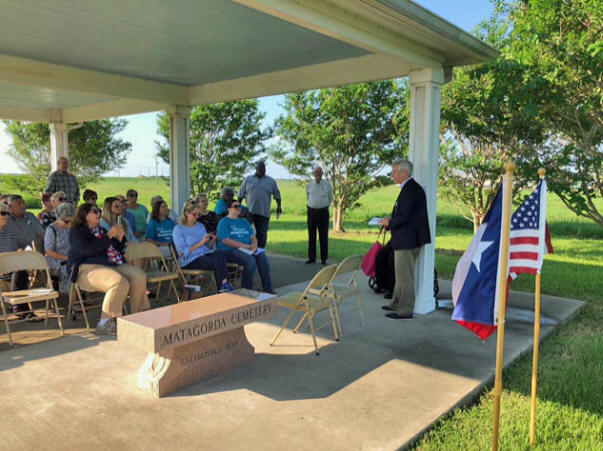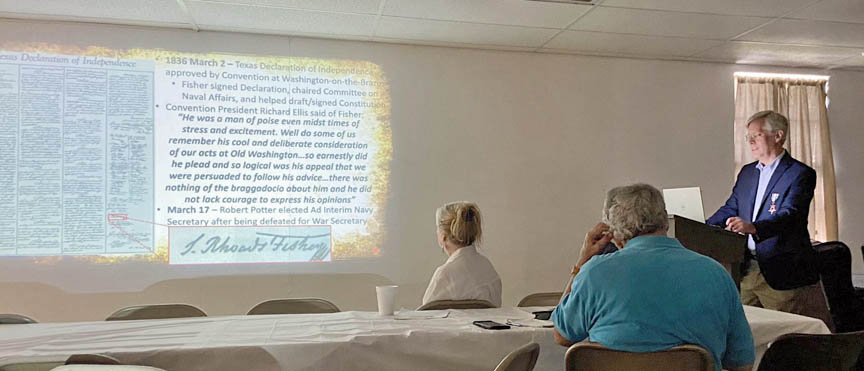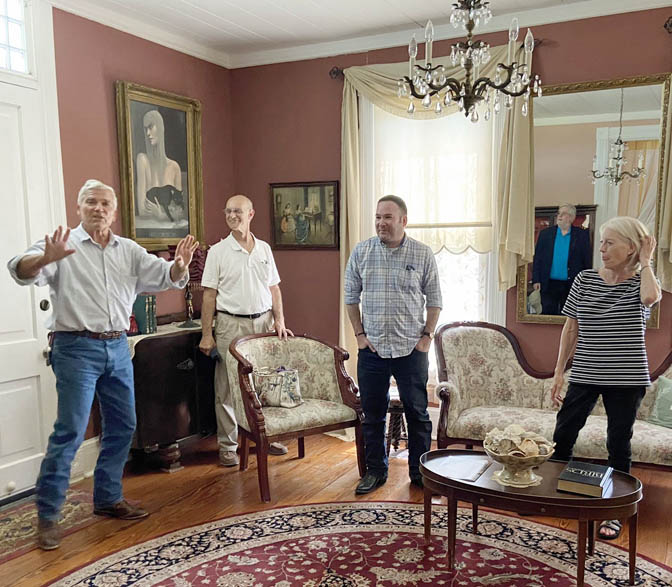|
||||||||
|
In 1844 Dallam went to
Washington on the Brazos., and compiled A Digest of the Laws of Texas;
Containing a Full and Complete Compilation of the Land Laws;
Together with the Opinions of the Supreme Court. Originally
printed in 1845, the book has been reprinted several times and has
retained its importance because present-day Texas jurisdiction is
based on the early laws of the Republic. In 1845 Dallam
returned to Matagorda (he first came to Matagorda in 1839), where on
October 1, he married
Ann Pleasants Fisher, the daughter of
Samuel
Rhoads and Ann Pleasants Fisher. Ann was born May 2, 1823. Dallam founded and
edited a weekly paper in Matagorda called The Colorado Herald. The
first issue in July. 1846, carried the motto “Give me liberty to
know, to utter, and to argue freely above all liberties.” Dallam
County, Texas is named for James Wilmer Dallam. Grant #32, containing
320 acres of land, was assigned to Dallam with his claim that he
arrived in Matagorda County prior to January 1, 1842. On one of his business
trips to New Orleans, he contracted yellow fever and died in New
Orleans August 20, 1847. Burial services were in Christ Church,
Matagorda, with interment in the cemetery at Matagorda. James and Ann had one little girl, Annie Wilmer Dallum, born March, 1847. On July 1, 1852, Ann Fisher Dallam married John W. Harris, a prominent lawyer. Three children were born to this marriage: Rebecca Perry Harris on June 5, 1853; Rhoads Fisher Harris on June 5, 1858; and Elizabeth Boyd Harris on November 20, 1860.
Historic Matagorda
County, Volume I, pp 57-58 |
||||||||
|
We published under our obituary head a few days since, an announcement of the death of James Wilmer Dallam, Esq., at New Orleans, but it escaped our notice at the time, or should not have passed without comment. Mr. Dallam was a young man of great promise, a son of Francis J. Dallam, Esq., of Baltimore, who had settled at Matagorda, Texas, where he had a fine practice in his profession of the law, and commanded the universal respect and esteem of his fellow citizens. He recently published in this city a large volume, entitled "Dallam's Digest of the Laws of Texas," a most valuable work, of nearly 700 pages, and one that has been spoken of in the highest terms by the press and bar of that State. His death will be mourned not only by his family resident in our city, but by a numerous circle of friends and associates.
The Baltimore Sun, Baltimore Maryland,
Tuesday, September 14, 1847 |
||||||||
|
The Republic of Texas that James Wilmer Dallam entered in 1839 was a newborn country of hardly three years of age. It was largely unsettled and opportunities abounded for a young man seeking his fortune away from all he had known. Compared to Maryland, it was a wild untamed country. Perhaps he had read the following quote of Davy Crockett which encouraged him to go to Texas. “I must say as to what I have seen of Texas, it is the garden spot of the world. The best land and best prospects for health I ever saw is here, and I do believe it is a fortune to any man to come here. There is a world or country to settle.” The town of Matagorda, organized in 1829, was a port town and an important gateway to the Republic. Opportunities were endless for adventurous emigrants from around the world. The first group of settlers was from the northeastern states of the United States and many more from the area followed in subsequent years. The town was in need of all kinds of businesses and professionals such as doctors and lawyers. James Wilmer Dallam was lured to Texas by its promise of fame and fortune and in 1839 made Matagorda his home. With little need for his law expertise, Dallam, who was a prodigious worker, moved to Washington-on-the-Brazos which was the temporary capital of Texas. He saw the need to transcribe, compile and publish the earliest records and laws of the Supreme Court of the Republic of Texas. Active in expanding business, he reached out to secure business and promote his hometown through the publishing of the only newspaper at the time in Matagorda. Always a visionary, he symbolized the spirit that characterized the movers and shakers of pioneer Texas. James Wilmer Dallam, the man whose writing is remembered as the author of the “Lawyer’s Bible” was born in the city of Baltimore, Maryland, on the September 24, 1818. He was the eldest son of socially and financially prominent parents, Francis Johnson Dallam (1787-1857) and Sarah (Wilmer) Philips Dallam (1789-1855). He was christened in Saint Peter’s Protestant Episcopal Church in Baltimore on April 22, 1821. His siblings were: Sarah Smith Dallam (1817-1892), Mary Ann Dallam (1820–1863), Edward Beadle Boothby Dallam (1822–1874) Elizabeth Cassandra Dallam (1824- ____) Frances Johnson Dallam (1827–1829) and Henry Clay Dallam (1828–1887). His ancestors had deep roots in Maryland and his great-great-grandfather, Robert Dallam was the owner of the country estate known as “Cranberry.” Dallam’s father, was born at Cranberry, later occupied the estate and was buried there in 1857. As was the common practice of the day for a boy in his position, young James was home schooled and later sent to Brown University, at Providence, Rhode Island. He was listed as a senior in the Catalogue of the Officers and Students of Brown University, For The Academical Year 1836-37. He graduated from Brown in 1837 and returned to Baltimore. There he studied law under Reverdy Johnson, the distinguished lawyer who later became the United State Attorney General. James W. Dallam, Esquire at the young age of 21 years, left the comfort of his home and immigrated to the second largest port city of Texas to connect with other American entrepreneurs who had relocated to Matagorda. He first entered Texas in 1839 as sworn to before the land grant commission. On April 30, 1840, Dallam was again in the port of New Orleans this time aboard the ship “Wave.” On October 19, 1840, Jas. W. Dallam and David Kerr, announced by a published handbill, their association together in practice of law under the firm of DALLAM & KERR located on Mulberry Street in bustling Matagorda. They listed references from Baltimore, Washington, New Orleans, and Galveston. However, the new law firm did not have a practice large enough to satisfy the aspiring Dallam, so he traveled to the provisional capital, Washington, where there was more judicial action. “In 1842, during an invasion of the Mexicans under General Vasquez, into Western Texas, President Houston, thinking the national records in danger, ordered their removal to Houston. In November, when by Executive proclamation Congress met at Washington. Here the capital remained until it was again established at Austin in 1845.” The temporary Capital of the Republic was meeting at Washington-on-the-Brazos, Washington County, where Dallam spent the winter of 1844. He compiled the five preceding years of the decisions of the Supreme Court of Texas. That book of court records was published in 1845 by his father in Baltimore and printed by John D. Toy. The title page read A Digest of the Laws of Texas Containing a Full and Complete Compilation of the Land Laws; Together With the Opinions of the Supreme Court by James Wilmer Dallam, of Matagorda, Texas. The 632 page volume was commonly known as “Dallam’s Digest.” In an advertisement in The Washington Union, Washington, District of Columbia, on June 20, 1845, Dallam gave a description of his soon to be published book. “It will comprise the period of legislation in the Republic of Texas, since the formation of the government to the close of the last Congress in January, 1845; with all the opinions of the Supreme Court at length; and the land laws which still govern and have governed since the first settlement of the country in 1824.” The notice closed with the following: “The author refers to the following gentlemen: Hon. Stevenson Archer, Chief Judge Court of Appeals, Maryland; Hon. Reverdy Johnson, U. S. Senator, Maryland; David Stewart, esq., Baltimore; Hon. M. B. Lamar, Texas; Hon. David S. Kauffman, Charge d’Affaires from Texas.” Since few briefs had been filed by the attorneys in the cases which had been decided by the Supreme Court of Texas, lawyers of the Republic soon regarded the book as almost indispensable in their practice. Being the only compilation of its kind on the laws of the Republic of Texas, it is still a reference for present-day lawyers. The most common criticism was that the book did not include the transition time between the Republic and statehood. Dallam further established his roots in Matagorda when he purchased 371 acres on the west side of the Trespalacios on July 4, 1842 from John D. Newell. That land was in turn sold to George W. Ward on November 24, 1843. Dallam bought and sold three lots in Matagorda County between 1842 and 1845. James W. Dallam was issued a 3th class land grant totaling 353.7 acres described in Bexar District by virtue of certificate No. 32, issued from the land office in Matagorda on January 5, 1846. The actual survey was in Medina County, about 15 miles north 45 degrees west from Hondo. Dallam’s contribution to the history of Texas was recognized in 1876 when Dallam County, located in the far northwestern corner of the Texas Panhandle, was named in his honor. Back in Matagorda on October 1, 1845, James W. Dallam married Ann Pleasants Fisher (1823-1908), the daughter of former Secretary of the Texas Navy, Samuel Rhoads Fisher (1794-1839) and Ann Pleasants Fisher (1796-1862). To this union on March 22, 1847 was born one daughter, Annie Wilmer Dallam (1847-1900). For a brief time, Dallam edited a weekly newspaper in Matagorda known as The Colorado Herald. The first issue in July 1846 carried the motto “Give me liberty to know, to utter, and to argue freely above all liberties.” Only four issues are known to exist, January 1, 8, 15 and 22, 1847. The Colorado Herald, which was published on Mulberry Street in Matagorda, was the forerunner of The Matagorda County Tribune, The Daily Tribune and currently in 2020, The Bay City Tribune. Later, Edward F. Gilbert took over the operation of The Colorado Herald and on October 18, 1847 changed the name of the paper and published the first issue as the Colorado Tribune. Besides his serious works in the law and newspaper field, Dallam wrote two short romances founded on incidents of Texas history. The Lone Star a Tale of Texas was published in 1845. His second novel The Deaf Spy was published in 1848, after his death. It was his newspaper ambition that brought about his untimely death. In 1847, he was approached to establish and edit a German and English newspaper in Indianola, known then as Indian Point. The new paper would be known as the Emigrant. He shipped his printing press to Indian Point in preparation to establish the paper. While on a business trip to New Orleans working on this new venture, he became a victim of Yellow Fever. According to the burial note in the original Christ Church records, he was ill “only 72 hours” when death ended his suffering on August 20, 1847. The body was taken to Daniel Monroe undertaker, located at 200 Camp Street, in New Orleans. His body was prepared and placed in a lead-lined mahogany coffin and transported to the ship that would return the body to Matagorda. Mr. Monroe charged the Estate of James W. Dallam $80 for his services. The body was transported to Matagorda by J. S. Brower on his schooner European for the charge of $50. An obituary for Dallam appeared in the Houston, Texas Democratic Telegraph and Texas Register on September 23, 1847. It had been reprinted from the Victoria Advocate. Died of Yellow Fever.—It is with unfeigned regret that we are called upon to announce the death of our much esteemed brother editor, James W. Dallam, Esq., late conductor of the Matagorda Herald. He died of the yellow fever at New Orleans, whither he had gone to procure the necessary materials for commencing a new paper at Indian Point. Mr. Dallam was distinguished among his acquaintances for his amiable deportment and social virtues, and as a member of the bar and of the editorial profession, few stood higher. He was indeed a bold and independent writer, and we sincerely lament his loss to the corps editorial, as well as sympathize with a disconsolate family he has left behind him.—Victoria Advocate” Dallam’s burial service was conducted on September 19, 1837 from Christ Episcopal Church, followed by interment in the cemetery east of the town where he resided for six years. For $5.00, his grave was dug by Stephen Taylor of Matagorda. Dallam’s death ended the life of a man whose intelligence gave promise of a future usefulness that was unfulfilled. After his death, his wife and daughter lived with her mother and other family members. The enumeration of the Matagorda County 1850 federal census recorded them as living in household #49 in Matagorda. Annie’s property value was $2000. Annie Fisher Dallam remarried on July 1, 1852, to John Woods Harris (1810-1887). The same day, Harris adopted Annie Wilmer Dallam “as his legal heir.” John and Annie Harris had six children, Rebecca P. Harris (1850-1900), John Woods Harris (1856-1918), Elizabeth “Lillie” Byrd Harris (1858-1900), Rhoads Fisher Harris (1860-1870), Wharton Harris (1864-1865) and Cora Lewis Harris (1868-1950. Harris died in 1887 and Annie Pleasants Fisher Dallam Harris died on October 29, 1906 and was buried with Harris at Trinity Episcopal Cemetery in Galveston, Texas. Dallam’s legacy would live on in his only child Annie Wilmer Dallam, who married Branch Tanner Masterson (1847-1920), and her children, Branch Tanner Masterson, Jr. (1872-1897), May Maud Wilmer Masterson (1875-1975), John Harris Masterson (1877-1905), Thomas Washington Masterson (1879-1950), Rebecca Byrd Masterson (1882-1969) and Wilmer Dallam Masterson (1884-1974). Annie, her half-sisters Rebecca and Lillie and eight other family members perished in the 1900 Galveston hurricane.
The youthful ambition paired with the alert mind
of this intelligent lawyer has contributed immensely to the
judiciary system of the state since 1845. Dallam’s Digest,
familiarly known as the “Lawyer’s Bible,” was first published in
1845. It has gone through reprints as late as 1904. His compilation
Opinions of the Supreme Court of Texas from 1840-1844, inclusive,
was published as a separate book in 1883. Because modern Texas
jurisprudence is based on the laws in effect in the Republic, the
Digest has retained its importance and is still today a vital tool
of Texas law. The county of Dallam perpetuates his memory. His
contributions to the state in the 28 short years of his life left a
legacy still of importance in Texas today. |
||||||||
|
Courtesy of Dallam Masterson |
||||||||
|
|
||||||||
|
|
||||||||
|
Mrs. Harris' maiden name was Miss Annie Pleasants Fisher. She was the daughter of Samuel Rhodes Fisher and his wife, Ann Pleasants both of Philadelphia, Pa., and was born there May 2, 1823. In 1832 at the age of 9 years she came with her parents and family to Matagorda, Tex., where Colonel Fisher had established himself in 1830 as a colonist under the Government of Mexico. He was one of the founders of the town of Matagorda. In the invasion of 1836 Mrs. Fisher and children were, with other refugees from Matagorda, on board a vessel of the Texas Navy at anchor in Galveston Bay when the battle of San Jacinto was fought. Afterwards, with the exception of several years of school in New York, the subject of this sketch grew to maturity in Matagorda in the days of the Republic of Texas; and her recollection of the characters and events of that stirring period were clear and most interesting. In 1845 she married, first James Wilmer Dallam, a well known lawyer and author of Dallam's Digest of the Laws of Texas; and by this marriage had one daughter, Annie Wilmer (Dallam), who was the wife of Branch T. Masterson, and mother of Hon. T. W. Masterson, Wilmer Masterson, Miss Reba B. Masterson and Mrs. May Masterson Fisher, wife of Judge Lewis Fisher, now of Galveston. Mrs. Dallam was left a widow in 1847 and on July 1, 1852, was married to Hon. John W. Harris, a native of Virginia, the first Attorney General of Texas as a state and for many years a distinguished lawyer and citizen of Galveston, where he died on April 1, 1887.
Captain Rhoads Fisher of Austin, Texas and the late Samuel W. Fisher, of Matagorda, Texas, father of Mrs. John W. Armstrong of San Antonio, were brothers of Mrs. Harris. After the death of Judge Harris in 1887 his widow remained in Galveston till the loss of their home and eleven members of the family in the disastrous storm of 1900. Mrs. Harris has since lived with her daughter, Mrs. Davenport, and for the past three years in San Antonio. Mrs. Harris was a lady of wonderful strength and charm of character, and personal influence. Her well poised, clear mind, sound judgment and unerring sense of right, with a warm, true heart were faithfully exercised through life in the cultivation of Christian graces and promotion of the happiness of those around her; and to the last the pleasures of the young or distressed and poverty of the aged alike met with her sure sympathy and wise help. The law of kindness was supreme with her. Possibly her most expressive encomium was that of an old neighbor in Galveston, who said: "I have known Mrs. Harris constantly and well for forty years, and never heard her say an unkind or unwise thing." Another said of her, that she was the only person he ever knew who was at once perfectly candid and perfectly polite. These traits were all the more remarkable in a person of her rare sense of humor and powers of expression. More than the usual vicissitudes and bereavements of a long life had been met by Mrs. Harris with Christian faith and fortitude, and her own last summons, patiently awaited, came as for a sheaf ripe for the harvest, to be gathered into the Lord's treasure house. Tender hands will lay her form beside her loved ones in the hope of a blessed resurrection and reunion in Heaven; and sorrowing hearts, left behind, will say "Devoted mother, wise counselor, dear friend, good-night." Daily Express, San Antonio, Texas, October 30, 1906
Marker photo courtesy of Patti Zapalac, Find A
Grave Volunteer #46583652 |
|
Photos courtesy of Katie Hutto
& G. W. Franzen |
||||||||||
|
||||||||||
|
By Wilmer Dallam Masterson IV It’s an honor for me to present this brief biography of my namesake and 3rd great grandfather James Wilmer Dallam.
He was
born in Baltimore 204 years ago in 1818. His mother’s father, James Jones Wilmer, was an Episcopal clergyman who became Chaplain of the US Senate and was an army chaplain during the Revolutionary War and War of 1812.
His father’s Dallam family ancestry included Thomas and Robert Dallam who were famous organ-builders in England, including a fabulous mechanical organ that Thomas Dallam personally delivered to Constantinople as a gift from Queen Elizabeth I to the Sultan of Turkey in 1599.
James was home-schooled and graduated Phi Beta Kappa from Brown University in Rhode Island in 1837 when he was 19 years old. At the graduation exercises he delivered a speech on “The Importance of the Union.”
After college he returned to Baltimore to study law with Reverdy Johnson, who later became the Attorney General for the US.
He obtained his law license in 2 years and at age 21, rather than wait to practice law at the crowded Baltimore bar, he left for the Republic of Texas to seek his fortune.
He arrived here in Matagorda sometime in 1839, which was also the year that his future wife’s father Samuel Rhoads Fisher was assassinated here. Fisher was the first Secretary of the Navy for the Republic of Texas, and I’ll much more to say about him at the Christ Church after this ceremony.
In 1840 Dallam opened a law office with David Kerr in Matagorda, listing references including the Chief Justice of the US Supreme Court (Roger Taney) and McKinney and Williams Company in Galveston among others.
Dallam made enough money from his law practice to acquire some property in the area, but in 1841 Santa Anna regained the Presidency of Mexico and in 1842 the Mexican army re-invaded the Republic of Texas. They occupied San Antonio twice and took prisoners back to Mexico, which caused Texas Courts to be suspended and Dallam’s income dried up.
On September 15, 1842, Dallam wrote a letter to his father describing the situation in Texas resulting from the Mexican invasions:
“There is no money in the country – and if there were, land is at present…wholly valueless”
But he goes on to say about Matagorda: “I have many warm friends here and no enemies – the society is agreeable and refined”
“Had peace continued…I did not despair of…marriage…For the present I can but hope – and…I sincerely believe that Time will satisfy me that I have not hoped in vain”
He didn’t disclose the object of his affection in the letter, but Fisher’s daughter Annie, who he later married, was 19 at the time.
With little legal work available, Dallam had the bright idea to publish the rulings of the Supreme Court during the Republic of Texas, which required him to relocate to the temporary State capital of Washington-on-the-Brazos where the Court had moved from Austin after San Antonio was invaded.
Dallam returned to Baltimore to print his book, and it was published in 1845 with the long title “Dallam’s Digest of the Laws of Texas: Containing a full and complete compilation of the land laws: together with the opinions of the Supreme Court”
His book came to be known as the “Lawyer’s Bible” because it included the Supreme Court rulings during the Republic, and for many years was required reading at Texas law schools.
The Digest portion of the book is an encyclopedic compilation of Texas laws listed alphabetically; just to give one example, Dallam’s discussion of laws against “Dueling” reads:
“The crime of dueling is severely reprobated and strict provisions made for its suppression; But laws in a community like ours [i.e. Matagorda] for such a purpose appear inoperative. Custom has given its sanction to a practice, which the Law would make a crime; and the fear of dishonor is more influential than the terrors of fine and imprisonment.”
Dallam also published a novel in 1845 called “The Lone Star: A Tale of Texas” which was an early linkage between Texas and “Lone Star” in print.
In his Preface to “Lone Star” Dallam wrote: “Texas is a land of beauty: in her sea-girt shores, in her emerald planes, in her shining rivers, in her rumbling cataracts, on her mountain tops, in her valleys, she is beautiful. But above all, she stands, at present, the outpost, the resting place, of Freedom, on its march, and…the gaze of the civilized world is fastened, anxiously and inquiringly, upon her.” I think those sentiments still ring true today, except he forgot to mention the mosquitoes…
Dallam returned to Texas in the fall of 1845 and married Ann Pleasants Fisher on October 1st, followed by several parties in Matagorda, which Mary Maverick in her memoirs called “the most cultivated society in the state.” Mary was jumping the gun a bit because Texas didn’t officially become a US state until Dec 29 of that year.
The next year, in July 1846, Dallam founded the Colorado Herald newspaper in Matagorda with the motto “Give me liberty to know, to utter, and to argue freely above all liberties.”
In March 1847 James and Ann were blessed with a daughter they named Annie Wilmer Dallam.
Five months later James was in New Orleans making business arrangements for establishing a new German/English newspaper at Indian Point (Indianola) when he caught yellow fever and died on August 20 after a three day illness. He was not quite 29 years old. His body was returned to Matagorda for burial services at Christ Church and interment here.
After Dallam’s death, his second novel “The Deaf Spy” was published in 1848. His daughter Annie Wilmer Dallam married Branch T. Masterson in 1868 and they had 7 children, one of whom was my great grandfather, Wilmer Dallam Masterson.
In 1876 the Texas Legislature passed a law stating, “The county of Dallam is named in honor of James W. Dallam, a laborious lawyer of the Texas Republic.” Dallam County is in the extreme northwest corner of the Texas Panhandle. Dallam’s Digest was reprinted in 1881, 1883, and 1904, and can still be found in law offices across the great State of Texas.
On behalf
of Dallam and Fisher descendants, thank you again for this wonderful
marker. |
||||||||||
|
||||||||||
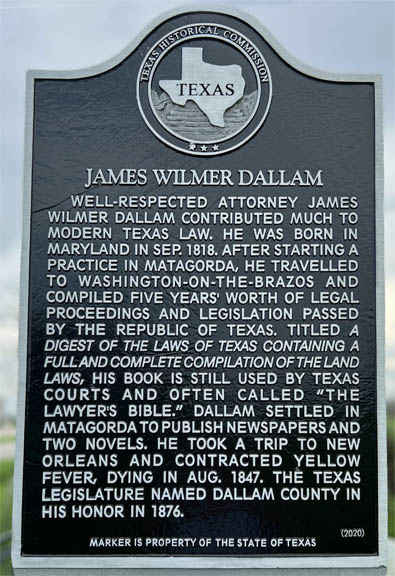
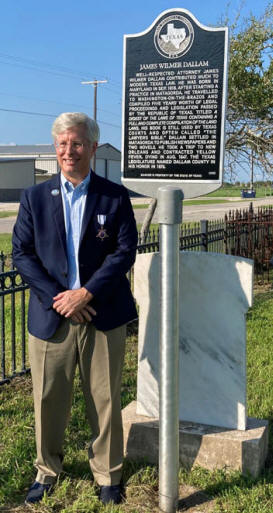
 James Wilmer Dallam
was born in Baltimore, Maryland, September 24, 1818, the son of
Sarah Wilmer and Francis Johnson Dallam. After graduation from Brown
University in 1837, where he was a member of Phi Beta Kappa, he
studied law in the Baltimore office of Reverdy Johnson.
James Wilmer Dallam
was born in Baltimore, Maryland, September 24, 1818, the son of
Sarah Wilmer and Francis Johnson Dallam. After graduation from Brown
University in 1837, where he was a member of Phi Beta Kappa, he
studied law in the Baltimore office of Reverdy Johnson.


 The announcement of the death of Mrs. Annie P.
Harris, widow of the late Judge John W. Harris of Galveston, will be
of sad interest not only to a wide circle of her friends in this and
other states, but also to the few remaining pioneer settlers of
Texas, now rapidly falling like autumn leaves. The funeral service
will be held today in Galveston.
The announcement of the death of Mrs. Annie P.
Harris, widow of the late Judge John W. Harris of Galveston, will be
of sad interest not only to a wide circle of her friends in this and
other states, but also to the few remaining pioneer settlers of
Texas, now rapidly falling like autumn leaves. The funeral service
will be held today in Galveston.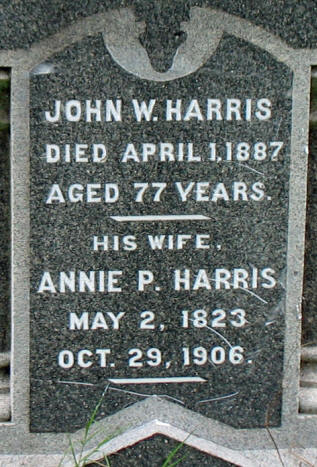 There were six children of this marriage, Rebecca
P. Harris, John W. Harris, Lillie Byrd Harris, Rhoads Fisher Harris,
Wharton Harris and Cora Lewis Harris; of whom there are now living
only John W. Harris of Galveston, and Mrs. Cora L. Davenport of San
Antonio, Tex.
There were six children of this marriage, Rebecca
P. Harris, John W. Harris, Lillie Byrd Harris, Rhoads Fisher Harris,
Wharton Harris and Cora Lewis Harris; of whom there are now living
only John W. Harris of Galveston, and Mrs. Cora L. Davenport of San
Antonio, Tex.




